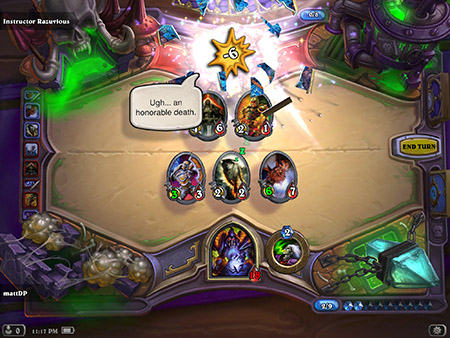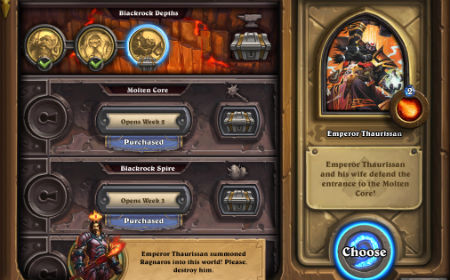Hearthstone: the building of Blackrock Mountain
There are methods in the madness of the meta

Blizzard announced this week that Hearthstone has passed the thirty million player mark.
Not bad for a game that started out feeling like an afterthought, belatedly aping the success of collectible card games like Magic: the Gathering.
Even if 29 million of those players are people who've tried out a free app never to play it again, those numbers are impressive. And they're a testament to how inviting and addictive the game is.
All by design, according to Jason Chayes, Production Director and Vice President at Blizzard. "With Hearthstone, our main goal was to develop a game that anyone could pick up, learn, and start having fun within 5 minutes," he told Pocket Gamer.
"We've also had a big focus on keeping the game experience charming. That comes through effects when cards come into play and a sense of physicality to everything you’re interacting with as a player."
"Plus there's the personality and sense of value attributed to the cards you're collecting, since they really are the stars of the game."

One of the fascinating things about the game is the way it uses the digital platform to make itself unique. It does things that the physical games that inspired it never could. Being so easy and accessible is just one example.
Eric Dodds, the Game Director on Hearthstone, has plenty more.
"We've removed a lot of the complexity of physical collectible card games while keeping a lot of depth," he explained. "The computer shows you which of your options are valid plays and which are valid targets for spells."
"If there is ever a question about how something will work, all you have to do is to play it and you will find out."
One of the other features of the game that would be hard to implement in a physical version is classes. But the different hero powers and card pools available to each class lead to some imbalances in the original game.

The first two expansions, Naxxramas and Goblins vs Gnomes introduced some cards to fix this. It looks like Blackrock, the newest addition, had the final pieces for this with cards designed to boost Warriors and Priests. But Eric disagreed.
"We like making neutral cards that interact with classes in different ways, such as the Grim Patron," he said. "The Patron spawns a new copy of himself if he takes damage, but doesn't die. For the mage that means that your hero power is pretty interesting because you can damage a Patron without another card."
"In the case of the priest, you can increase the health of the Patron and give it more chances to survive. For the warrior, you have lots of ways of doing 1 damage to your own minions so you can build an army of Patrons pretty quickly."
The other notable trend in Blackrock is cards that change effect depending on what else you have in your hand. I thought this was an attempt to trade off quick power-ups against transparency. However, Eric put me straight with a surprising answer.

"That was a mechanic that we added specifically for dragons," he revealed. "We really wanted players to be able to play some of the high cost dragons in Hearthstone and have a way of making a deck that was themed around those dragons."
"The problem is often you have the cool dragon in your hand, but the game is decided before the dragon actually comes into play. We wanted it to be cool just to have the dragon in your hand."
All the new cards introduced in Blackrock and the other expansions have the potential to radically change the balance of the game. They also impact what's called the 'meta', the ebb and flow of deck styles becoming popular until other players find a way to beat them.
Given how many new combinations each expansion creates, testing this must be a nightmare. I had assumed it must involve some sort of predictive model, but Eric put me straight again.

"I love the belief that we have predictive models about how the meta-game will change over time," he laughed. "That's high praise given how it actually works! What we have is a team of smart and skilled balance designers. They make tons of decks and play them against each other to get a sense of which cards are going to be played and in what types of decks."
Of course, it doesn't always go to plan. "While their predictions are generally pretty good, there are tons of deck styles we didn't predict that end up doing well in the meta-game," he continued. "We love that while we balance the game, the players are the ones who own it."
They've had plenty of practice at this, of course, since Blackrock is the second solitaire expansion for the base game. The first, Naxxramas, drew some criticism for the weakness of the opponents and lack of replay value. So I naturally wondered what Blizzard had learned from the experience.

"We structure the difficulty of our adventures with the goal of creating a fun way to earn new cards," Jason replied. "It's important that all players can gain access to the card rewards when purchasing wings with their hard earned gold or real money. So, those particular missions are not designed to be an immense challenge."
Another peculiarity of the solo adventures for Hearthstone so far is their wing structure. This forces you to tackle each boss in turn in a straight-up fight. So there's no potential for exploration and a restricted amount of narrative for the player.
Jason, however, was keen to emphasise the story building potential of treating the bosses as individuals. "It creates a self-contained thematically consistent mini-dungeon that lets us showcase a few exciting bosses at once," he explained.
"That gives our design team a chance to try out some interesting mechanics and lend some cool personality to the enemies you're facing without impacting the overall structure of the game."

Ultimately, though, the oddest thing about both Blackrock and Naxxramas might be the price. Hearthstone offers a scrupulously fair free to play model for card packs. But the solo adventures are different. In terms of exchange rates for in-game gold, it works out better value to buy them with real money.
This departure made me wonder whether or not Hearthstone is proving to be the cash cow that everyone assumes it must be.
Jason was quick to put me straight. "We're very happy with how Hearthstone has been doing since release," he told me. "We remain committed to making sure that players can acquire cards, adventures, and any other part of the game that affects gameplay just by playing and accumulating gold over time."
"That's a very important part of our philosophy and fundamental to our goal of keeping Hearthstone accessible to everyone that wants to play."
And that philosophy is, I'm certain, the key to the success of the game. Whether certain things are better value with real money or not, anyone can succeed in Hearthstone without spending a penny. It takes a bit of luck, but when the game is so accessible, there's nothing to stop you chancing your arm.
So if you feel like it, give it a go. Who knows, maybe this time next year, you'll be one of those millions of regular players.
